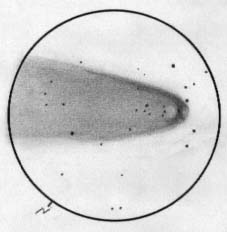 This is my first telescopic view of the comet since it emerged from solar conjunction. The sketch at left captures the view in my 10-inch Starfinder Newtonian. The structure around Hale-Bopp's pseudo nucleus is startling. Five jets are visible at low power (Meade 18-mm SWA) with the strongest jet emitting vast quantities of gas and dust to the north. A pair of hollows are visible within the coma near the pseudo nucleus. The comet also displays an overall greenish hue. The view through my Swift 10X50 binoculars is equalling stunning. Hale-Bopp's ion tail can be followed for about 8-degrees to the northeast before becoming lost in the Milky Way. The shorter dust tail is visible for about 3-degrees curving west-southwest. The ion tail is visible for the same 8-degrees with the naked eye. Comet Hale-Bopp already is the equal of Hyakutake as a telescopic object. Just think, we still have six weeks until perihelion. Oooh!
This is my first telescopic view of the comet since it emerged from solar conjunction. The sketch at left captures the view in my 10-inch Starfinder Newtonian. The structure around Hale-Bopp's pseudo nucleus is startling. Five jets are visible at low power (Meade 18-mm SWA) with the strongest jet emitting vast quantities of gas and dust to the north. A pair of hollows are visible within the coma near the pseudo nucleus. The comet also displays an overall greenish hue. The view through my Swift 10X50 binoculars is equalling stunning. Hale-Bopp's ion tail can be followed for about 8-degrees to the northeast before becoming lost in the Milky Way. The shorter dust tail is visible for about 3-degrees curving west-southwest. The ion tail is visible for the same 8-degrees with the naked eye. Comet Hale-Bopp already is the equal of Hyakutake as a telescopic object. Just think, we still have six weeks until perihelion. Oooh! |
![]()
![]()
